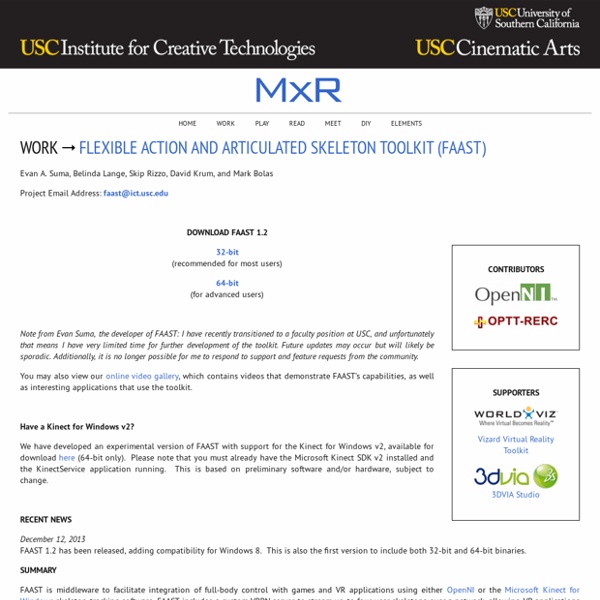Install FAAST on your PC
Install FAAST on your PC for full body control and VR applications: Disclaimer: This comprehensive guide of FAAST installation was taken from Institute for Creative Technologies website. Summary FAAST is middleware to facilitate integration of full-body control with games and VR applications. FAAST is free to use and distribute for research and noncommercial purposes (for commercial uses, please contact us). The preliminary version of FAAST is currently available for Windows only. Installation To use FAAST, you will need to download and install the following software: OpenNI Unstable Build for Windows v1.0.0.25PrimeSense NITE Unstable Build for Windows v1.3.0.18 During NITE installation, enter the free license key from OpenNI: 0KOIk2JeIBYClPWVnMoRKn5cdY4=Hardware drivers for your sensor (only one of the following) Microsoft Kinect: SensorKinect Module – download Win32 installer from Bin folderPrimeSensor: PrimeSensor Module – this does NOT work with the Kinect Skeleton Usage Action List
avin2/SensorKinect - GitHub
Separation of the Interstellar Boundary Explorer Ribbon from Globally Distributed Energetic Neutral Atom Flux
N. A. Schwadron1,2,14, F. Allegrini2,3, M. Show affiliations n.schwadron@unh.edu harald.kucharek@unh.edu eberhard.moebius@unh.edu fallegrini@swri.edu dmccomas@swri.org maldayeh@swri.edu george.livadiotis@swri.org mreno@swri.edu bzowski@cbk.waw.pl eric.r.christian@nasa.gov gbc@space.mit.edu roland@space.mit.edu Bob.DeMajistre@jhuapl.edu Edmond.Roelof@jhuapl.edu frisch@oddjob.uchicago.edu hfunsten@lanl.gov kgoodri@lanl.gov stephen.a.fuselier@lmco.com mikeg@usc.edu paul.janzen@umontana.edu dan.reisenfeld@umontana.edu cprested@bu.edu jacob707@gmail.com
Kinect | Open Virtual Worlds
John introduces the story telling room at the Timespan museum in Helmsdale. Timespan’s virtual museum. What’s been happening in virtual worlds research at St Andrews? Summer dissertations ended in August. We had great fun supervising the students, and thank them for all their hard work. Dissertation Titles: A Toolkit for Managing Open Virtual World GridsMultimedia and Interactivity in Virtual Worlds using a Reconstruction of Linlithgow PalaceEducational Environments: A Virtual Resource for Computer NetworkingRouting Island: Internet Routing in a Virtual WorldA virtual reconstruction of St Andrews CastleVirtual St Andrews: Virtualising the Libraries Special Collections Summer dissertation students Pictures of the students at their poster demo sessions can be viewed on the open virtual worlds facebook page. We have Dr. Look out for virtual worlds in Scotland History magazine in the Jan/Feb issue. Cathedral Reconstruction Projects Collage
Kinect Open Source Programming Secrets
Kinect Open Source Programming Secrets (KOPS) is the only book that explains the official Java wrappers for OpenNI and NITE. (If you want installation instructions, scroll down this page a little.) The main drawback of using the PrimeSense Java wrappers is their lack of documentation. As I explain in chapter 1, I had to decompile the libraries' JAR files, and work out the correspondences between the Java source and the somewhat better documented C++ OpenNI/NITE APIs. This is why including "secrets" in the book's title isn't too excessive :). This book covers programming topics not found elsewhere. Early (sometimes very early) draft versions of KOPS's chapters can be downloaded from here (see the links below). If you're looking for Killer Game Programming in Java then it's here. What this Book is Not About I'm concentrating on the Kinect without including chapters explaining OOP concepts such as classes, objects, and inheritance. Dr.
KinEmote User Forums • Index page
Sabbath School Lessons for Everyone
English Sabbath School Bible Study Guides and Helps This quarter's Bible study is titled Garments of Grace: Clothing Imagery in the Bible .(Click on the title or the cover picture at the right.) The Adult Sabbath School Bible Study Guides (once called Sabbath School Lessons) are prepared by the Office of the Adult Bible Study Guide of the General Conference of Seventh-day Adventists. You may order a print or Audio copy of this Bible Study Guide online at the Adventist Book Center . Adult Bible Study Guides in PDF format Teachers Edition , Standard Edition , Easy Reading Edition Modified PDF of Standard Edition lesson includes short verses as pop-ups and long verses as linked pages in the same pdf files. Sabbath School Bible Study Podcasts Essential for the vision impaired and also great for busy people, playable on iPods, mobile phones and other podcast-supporting devices. Email Discussion of the lessons in the Adult Bible Study Guide and related topics.
Ambientes de ensino
Kinect & HTML5 using WebSockets and Canvas - Vangos Pterneas blog
Kinect defined Natural User Interaction. HTML5 redefined the Web. Currenty, there are various tutorials describing how to interact with a Kinect sensor using Windows Forms or WPF for the user interface. But what about using a web interface for handling Kinect data? Trying to combine those two hot, cutting-edge technologies, I came up with a pretty and open-source solution, which I am going to describe in this blog post. I am going to use the official Kinect SDK for my demo, but same principles apply to OpenNI SDK, too. Download source code and binaries Prerequisites Results The project consists of two sub-projects: A server-side application which uses Kinect SDK and a client-side web page displaying the skeleton joints on an HTML5 canvas. Client application: Server application: Tutorial Here is, step by step, a way to achieve the above functionality: Step 1: Server application Considering the data transmission, I highly recommend the use of Fleck. Step 2: Client application Time for HTML5 bits!
Interactive Media Division
Throughout the course of my degree progress, one debate raised our very first class meeting of our first year was the concept of traditional authorial narrative vs. emergent narrative. Traditional authorial narrative is what we’ve come to know as our film-based non-interactive media, whereas emergent narrative is procedurally generated by way of a designed system. As I head towards the end of my second year, it’s less of a balanced argument— traditional narrative in games (Ludus, as named by Roger Callois in Man, Play and Games,) seem to be relying on their predecessors as a clutch, while systemic narrative (Paidia) is beginning to show the uniqueness of the new medium that we’re witnessing mature before our eyes. Now as more and more games are transitioning to paidia-based mechanics, traditional narrative in gameplay might start to be viewed as a skeuomorphic artifact from a pre-interactive era. This actually has to do with the concept of “free will”.
OpenSim



